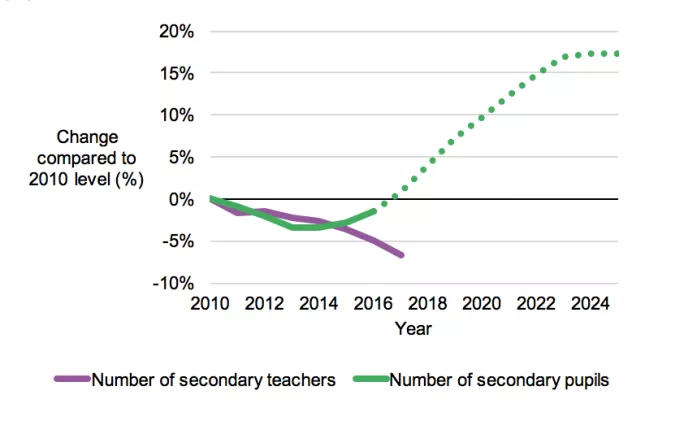- Home
- ‘The UK’s teacher supply is leaking... and fast’
‘The UK’s teacher supply is leaking... and fast’

The latest statistics on teacher retention in England will make for sober reading within the Department for Education. The perfect storm that has been gathering for several years, of rising secondary pupil numbers, below-target recruitment numbers and increasing numbers of teachers leaving the profession, is finally hitting.
No wonder then that Nick Gibb’s new top priority is to “ensure there are sufficient high-quality teachers in our schools for the long term, by delivering our teacher recruitment and retention strategy”.
The big teacher supply challenge of the next decade is to have enough secondary teachers to meet growing demand. The number of secondary teachers has fallen since 2010, but has been roughly in line with falls in the number of pupils.
However, the number of secondary pupils is forecast to grow by 19 per cent over the next decade as the swell in pupil numbers that has been going through primary schools since 2010 finally hits secondaries. The pupil bulge has already started to hit, but the teacher bulge is yet to materialise. Worse still, the overall number of secondary teachers is falling fast, pushing the average pupil-teacher ratio from 14.9 in 2011 to 16.0 in 2017.
The number of secondary teachers has continued to fall, despite growing numbers of pupils

Recruitment hit by more teachers leaving
Another key reason why the recruitment targets have been getting more challenging is that the school system is retaining fewer teachers. In 2016-17, 9.9 per cent of teachers left the workforce, compared with 9.2 per cent of the workforce in 2010-11.
Looking at secondary schools alone, the figures are even higher: 10.4 per cent of secondary teachers left the workforce last year, compared with 9.4 per cent in 2010-11. The overall average also masks variation by subject: NFER and DfE research shows leaving rates are higher still among maths, science and modern foreign languages teachers. Filling the leaky bucket with more water is all well and good, but more holes appearing makes it harder to maintain (or increase) the water level.
The nature of retention has also shifted over time, away from natural replacement of retiring teachers to large numbers of working-age teachers leaving. Overall, the number of working-age teachers leaving the profession has increased from 25,000 in 2010-11 to 36,000 in 2016-17. Fewer teachers retiring has offset the rise in working-age teachers leaving to some extent, but not enough to stop the overall leaving rate climbing.
The fall in retirements is related to recent changes in the age distribution of teachers. The proportion of teachers aged 50 or over has fallen from 23 per cent in 2010 to just 17 per cent in 2017. Fewer teachers are making it through a full career in an increasingly demanding profession. As our research has shown, long working hours are likely to be contributing to this.
The retention rates of early career teachers are also lower now than they were a few years ago. Around 87 per cent of teachers who entered teaching remained in the profession at the end of their first year, which was a figure that hadn’t changed since 2010 - until this year when it decreased to 85 per cent. Worse still, the three-year retention rate has dropped from 80 per cent in 2011 to 73 per cent in 2017 and the five-year rate has dropped from 73 per cent in 2011 to 67 per cent in 2017.
Early career teachers need more support
These are the critical years where the right opportunities, nurture and support can make or break a career in teaching. The government’s proposal for an early career content framework presents a welcome opportunity to develop a package of development that supports early career teachers to remain in the profession.
The government’s teacher recruitment and retention strategy needs to have a sharp focus on supporting this group, in particular, and supporting schools to retain them. Having spent around £20,000 training each NQT, plus up to £30,000 for bursaries in key subjects, the government has a value-for-money interest in making sure that many of them stay. School leaders also have a big role to play in valuing and supporting teachers early in their career: NFER research has shown that recognition and reward are key to staff engagement and retention.
Today’s data paints a bleak picture for teacher supply in England. The government has made initial efforts at tackling this issue, but unless further action is taken urgently to improve teacher recruitment and retention, teacher shortages are going to get even worse over the next few years
Jack Worth is a senior economist and school workforce lead at the National Foundation for Educational Research. He tweets at @worth_jack
Keep reading for just £1 per month
You've reached your limit of free articles this month. Subscribe for £1 per month for three months and get:
- Unlimited access to all Tes magazine content
- Exclusive subscriber-only stories
- Award-winning email newsletters



